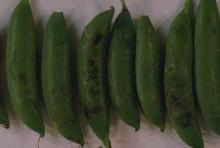Cause A bacterium, Pseudomonas syringae pv. pisi, that is internally seedborne and can survive in pea straw from one season to the next. This disease can be a problem in extremely wet springs where sprinkler irrigation is used and if seed for this year's crop came from a blight-infested field.
Symptoms Initial symptoms are small, water-soaked spots on leaves, pods, and stems. Lesions eventually coalesce, and leaves turn brown and die. Affected areas are translucent. Lesions often girdle the stem, killing tissues above. Tissue at the nodal area (where the stem leaflet is attached) can be severely infected also.
Cultural control
- Thoroughly disinfect equipment used to harvest a blight-infested field if equipment will be used to harvest a clean field, because seed contamination can occur readily.
- Use pathogen-free seed. Seed produced in dry areas without overhead sprinkler irrigation is usually free of blight. Using seed from the Willamette or Skagit valleys is not recommended.
Chemical control
- Badge SC (Group M1) at 0.5 to 2.5 pints/A on 7-day intervals. Preharvest interval is 0 days. 24-hr reentry for greenhouse use; 48-hr reentry for all other applications.
- Cueva (Group M1) at 0.5 to 2 gal/100 gal water on 7- to 10-day intervals. May be applied on the day of harvest. 4-hr reentry. O


